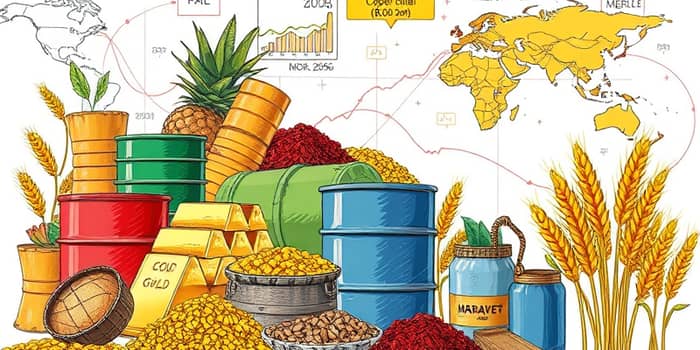
Global commodity markets represent the trading of essential raw materials, from energy to agriculture. These assets drive economic activity, influence inflation, and shape geopolitical relationships worldwide.
By breaking down trends, forecasts, and strategic drivers, this article offers practical guidance for investors and decision-makers navigating complex market dynamics.
Commodity markets serve as platforms where raw or primary products exchange hands between producers and consumers. These markets ensure price discovery and risk management through futures and spot contracts.
Commodities are broadly classified into hard and soft commodities, each with unique characteristics and market drivers.
Beyond physical trading, derivatives such as futures and options allow participants to hedge against price fluctuations, ensuring predictable costs and revenues for producers and consumers alike.
Each day, millions of barrels of oil, tons of metals, and bushels of grain trade hands on exchanges such as ICE and CME Group, reflecting real-time economic activity and future expectations.
Forecasts suggest a gradual decline in overall commodity prices in 2025, driven by improved global supply conditions and moderated demand. Supply chain adjustments and policy shifts add further complexity.
Key sectoral projections include energy, metals, and agriculture, each reacting differently to economic headwinds and regional developments.
Despite these projections, markets remain subject to volatility from geopolitical risks and elections, which can abruptly shift supply-demand balances.
Volatility metrics for commodities have trended upward, reflecting uncertainty around policy decisions and macroeconomic indicators. Emerging market demand, especially from developing economies, adds both upside potential and additional risk factors.
Inventory levels in warehouses and tank farms serve as critical indicators of market tightness or oversupply. Metals warehouses report rising stocks, while oil reserves fluctuate with production and seasonal demand shifts.
Each commodity category exhibits distinct dynamics in response to global economic and political factors. Investors should consider both macro and micro drivers for informed decision-making.
Oil and Natural Gas: A growing surplus in supply has pressured prices, with Brent crude expected to average below $70 per barrel by late 2025. Strategic stockpiles and OPEC+ production decisions will remain critical.
Precious Metals: Gold and silver achieved record highs in 2024, supported by inflation hedging and safe-haven demand. While price growth may moderate, fundamentals remain robust.
Critical Metals and Minerals: Demand for copper, lithium, and rare earth elements accelerates with the clean energy transition. However, capital access challenges and regulatory hurdles constrain some projects.
Nickel and cobalt markets remain under scrutiny as battery manufacturers secure long-term supply agreements. Price premiums for sustainable, responsibly sourced minerals continue to shape procurement strategies.
Agricultural Commodities: Food security concerns and climate variability shape crop yields and price fluctuations. Key staples like wheat and corn, along with cocoa and coffee, require close monitoring of weather patterns and policy interventions.
Climate patterns, from El Niño to droughts, can cause sudden supply shocks. Strategic grain reserves and crop insurance programs help mitigate the impact of adverse weather events on food prices.
Biofuels, derived from agricultural feedstocks, link energy and agriculture markets, with policy incentives driving demand for ethanol and biodiesel products.
Commodity prices reflect an interplay of supply-demand balances, geopolitical tensions, and macroeconomic trends. Understanding these forces is essential for anticipating market moves.
Advances in extraction technologies, including hydraulic fracturing and deep-sea mining, have lowered production costs in some sectors, creating new supply corridors and altering competitive landscapes.
Navigating volatile commodity markets requires expertise and disciplined risk management. Experienced traders leverage a mix of fundamental and technical analysis to identify opportunities.
Robust risk management practices, such as stop-loss orders and portfolio diversification, help manage downside risks associated with sudden price swings.
Quantitative strategies, including algorithmic and trend-following models, have grown popular, leveraging large datasets and machine learning to forecast price movements and optimize trade execution.
Some traders employ cross-asset hedging, using correlated instruments like currencies or equities to offset commodity exposures, enhancing portfolio resilience during market shifts.
Regional shifts in production and consumption patterns significantly influence global commodity flows. Awareness of these trends is vital for strategic positioning.
Asia and the Middle East: New capacity expansions, particularly in petrochemicals and steel, drive increased exports as domestic demand softens.
Latin America and Africa: Rich in critical metals, these regions face investment and infrastructure gaps even as global demand rises.
China’s Influence: As the largest consumer of copper and steel, China’s policies on production, stockpiling, and environmental regulations shape global price trends.
European markets continue to pivot toward cleaner energy sources, reducing coal consumption and increasing imports of renewable-related metals like palladium and nickel for battery production.
Commodity markets stand at the crossroads of economic cycles, geopolitical developments, and technological advancements. While 2025 may usher in price declines in several sectors, shifts in supply-demand balance dynamics and emerging trends will create pockets of opportunity.
Investors and policymakers should monitor key indicators such as inventory levels, policy reforms, and infrastructure investments. A proactive approach, grounded in rigorous analysis, will be essential for capitalizing on the evolving commodity landscape.
Looking ahead, sustainability initiatives and digital transformation offer new avenues for growth, innovation, and resilience in the raw materials sector. By combining strategic foresight with disciplined execution, stakeholders can unlock value and navigate uncertainty in global commodity markets.
By fostering collaboration between industry stakeholders, innovators, and policymakers, the commodity sector can navigate uncertainty more effectively and build resilient supply chains for the future.
References













